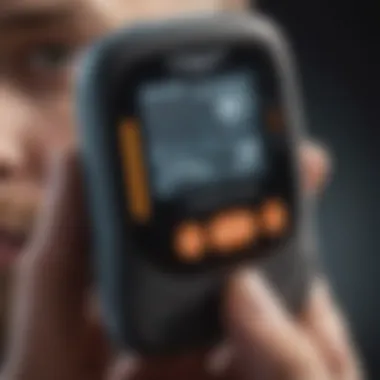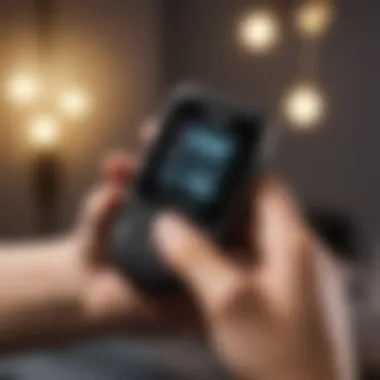Comprehensive Guide to Using Pulse Oximeters at Home


Intro
Pulse oximeters have gained significant attention in recent years, especially with the increased focus on monitoring health at home. These compact devices are essential for patients with respiratory issues, athletes, and those who want to monitor their general wellness. Understanding the technology behind pulse oximeters and knowing how to use them effectively is crucial for anyone seeking to take charge of their health.
This guide offers a detailed exploration of pulse oximeters, their benefits, practical usage tips, and much more. With a clear framework, it aims to equip users with the knowledge necessary to incorporate pulse oximeters into their health management routine.
Key Benefits
Using a pulse oximeter at home can provide various benefits.
Physical Health Benefits
One of the main advantages is the ability to monitor oxygen saturation levels. An optimal oxygen saturation level typically ranges from 95% to 100%. If levels drop below this range, it may indicate respiratory problems or other health issues requiring attention. By tracking these readings regularly, individuals can gain insights into their lung function, allowing for timely interventions.
Additionally, pulse oximeters can serve as a critical tool for patients suffering from chronic conditions like COPD or asthma. Patients can monitor their status, alerting them to any worsening symptoms that could lead to serious complications.
Mental Well-being Enhancements
Aside from physical monitoring, pulse oximeters also contribute to mental well-being. Knowing one's oxygen levels can alleviate anxiety, especially for those with health concerns. An understanding of their health data allows individuals to feel empowered and informed. This can foster a sense of control over one's health, promoting better mental health overall.
"Knowledge is power. Being aware of your health status can significantly affect how you approach your overall wellness strategy."
Practical Tips
Incorporating a pulse oximeter into your health management can be straightforward with the right practices. Here are some tips for effective use:
Regular Monitoring
Make it a habit to check your oxygen levels at the same time each day. Doing so can help create a reliable pattern and improve the accuracy of your readings.
Proper Usage
Ensure that you are using the device correctly. Place the oximeter on a warm, clean finger, and avoid movement during the reading for the best results. Follow the manufacturer's instructions for optimal use.
Interpret Readings Accurately
Understand what your readings signify. If you frequently experience low oxygen levels, consult a healthcare provider for further evaluation.
Record Keeping
Keep a log of your oxygen saturation levels. This can help identify trends or changes over time that may require medical attention.
Integrating pulse oximeters into home health practices can lead to more informed decisions about health management. The insights provided allow users to maintain their well-being through proactive monitoring and timely medical consultations.
Understanding Pulse Oximeters
The topic of pulse oximeters is essential in the field of health, especially for home monitoring. Pulse oximeters serve a vital role in assessing oxygen levels in the blood. This is particularly relevant for individuals with chronic conditions or those recovering from surgery. Understanding how these devices function can enhance the user's capability to manage their health effectively.
Definition and Functionality
A pulse oximeter is a non-invasive device that estimates the oxygen saturation levels (SpO2) in a person's blood. It typically clips onto a finger or earlobe for measurement. The device works by emitting light wavelengths that penetrate the skin, measuring the absorption of light by blood. This functionality is crucial for timely assessments of respiratory health, allowing users to monitor their condition without the need for invasive procedures.
The Science Behind Pulse Oximetry
The technology behind pulse oximetry relies on photoplethysmography. Light emitted from the device passes through vascular tissue, allowing it to detect changes in blood volume with each heartbeat. The two different light wavelengths emitted distinguish between oxygenated and deoxygenated hemoglobin. Understanding this scientific principle is important for users as it underlines the accuracy of readings and helps in recognizing potential discrepancies due to external factors like bright light or poor circulation.
Types of Pulse Oximeters
There are several types of pulse oximeters available, each designed to cater to different needs and contexts. Among them are:
Finger Pulse Oximeters
Finger pulse oximeters are the most common type. They are portable and easy to use. A significant characteristic is their compact design, which allows for use in various settings. Their accuracy is generally high, making them a preferred choice for home monitoring. However, users should take care that the device is fitted snugly, as a loose fit may lead to inaccurate readings.
Wrist Pulse Oximeters
Wrist pulse oximeters provide convenience for users who need continuous monitoring. This type is worn on the wrist and may feature additional functionalities like heart rate monitoring. Their primary advantage is comfort during long-term use. However, they tend to be less preferred for immediate spot checks compared to finger models. Users should consider their specific needs for either continuous or sporadic usage.
Handheld and Portable Devices


Handheld or portable pulse oximeters combine functionality and flexibility. These devices can be used in both clinical settings and at home, providing reliable readings when needed. The key advantage is their versatility; however, they can be more expensive and slightly more complex to operate. Users might find the larger screens beneficial for more detailed information compared to finger or wrist devices.
Pulse oximeters stand out as indispensable tools in managing respiratory health and are vital for both patients and health professionals alike.
The Importance of Home Monitoring
Home monitoring has become essential for many individuals, especially those dealing with chronic illnesses. This process allows for continuous observation of health metrics, fostering timely interventions when necessary. Pulse oximeters play a significant role in this aspect as they provide critical data about blood oxygen levels. Understanding how and why to monitor health at home helps individuals stay informed and proactive.
Chronic Illness Management
Managing chronic illness effectively is crucial for maintaining quality of life. Various conditions require regular monitoring to prevent complications. Pulse oximeters equip individuals to engage in self-management actively. This technology contributes by offering real-time insights into one’s health status.
Asthma Management
In asthma management, monitoring oxygen saturation is particularly important. Asthma can cause fluctuations in breathing, hence affecting oxygen levels in the body. By using a pulse oximeter, individuals can track their SpO2 levels, providing crucial data to guide treatment decisions.
The key characteristic of asthma management through pulse oximetry is its ability to detect early signs of an asthma attack. Having the means to monitor these levels at home allows patients to be proactive, minimizing visits to medical facilities.
A unique feature of this approach is the accessibility of real-time data. This information enables users and healthcare providers to adjust treatment plans quickly, leading to enhanced asthma control. The advantage here is the empowerment of patients, helping them feel more in charge of their health.
COPD Monitoring
Chronic Obstructive Pulmonary Disease (COPD) also benefits significantly from pulse oximetry. Regular monitoring can help individuals understand how their lungs are functioning each day. Keeping track of oxygen levels helps in identifying exacerbations early.
The key characteristic of COPD monitoring is consistency. Patients often experience daily variations in their condition, and tracking these variations is vital. The popularity of using pulse oximeters lies in their ability to provide actionable data without the need for invasive procedures.
The unique profile of COPD monitoring through this technology is particularly advantageous. Patients gain insight into when to seek help, avoiding severe health declines. However, reliance solely on a pulse oximeter without professional guidance can lead to misinterpretation of readings.
Post-Surgery Care
Post-surgery care necessitates vigilant monitoring of oxygen levels. Patients often have compromised lung function immediately after surgery, hence the need for close observation.
The key characteristic is the close relationship between oxygen saturation and surgical recovery. In post-surgery situations, having a pulse oximeter can provide immediate feedback regarding recovery progress. This makes it a highly beneficial choice for monitoring.
The unique feature of using a pulse oximeter after surgery is the ability to detect potential complications early. Early detection can lead to timely medical intervention, potentially averting more serious issues. However, there is a need for context—doctors must explain what normal readings look like during recovery phases.
Before and After Physical Activities
Monitoring oxygen saturation before and after physical activities can aid in optimizing performance and ensuring safety. Athletes or individuals engaging in exercise may use the data to gauge their fitness levels and ability to recover after exertion. Understanding these metrics can improve training regimens and enhance overall health management strategies.
Selecting a Pulse Oximeter for Home Use
Choosing the right pulse oximeter is a critical step in effectively monitoring your health at home. With various options available, understanding the features, price points, and where to purchase is essential. Selecting a suitable device can enable early detection of potential health issues and promote timely care. As people increasingly manage health from their homes, the pulse oximeter stands out as an invaluable tool. Let's explore the primary considerations of choosing a pulse oximeter for home use.
Key Features to Consider
Accuracy and Reliability
Accuracy and reliability are pivotal attributes to look for in a pulse oximeter. A device that consistently produces precise readings is essential for effective monitoring. Accuracy can be impacted by various factors, including movement during measurement and poor blood circulation. Therefore, selecting a device that minimizes these inaccuracies is vital.
Reliable measurements provide peace of mind for the user. Many high-quality models utilize advanced sensors that enhance measurement precision. When choosing a pulse oximeter, consider those models that have undergone rigorous testing and received positive reviews for accuracy.
Ease of Use
Remove complexity from health monitoring by focusing on ease of use. A pulse oximeter should be simple to operate, with straightforward instructions. Features such as one-button operation can significantly enhance user experience. This simplicity is particularly important for older adults or individuals unfamiliar with technology.
Additionally, look for pulse oximeters that come with clear instructions and intuitive designs. A user-friendly interface can facilitate regular use, ensuring consistent monitoring, which is crucial for effective health management.
Display Quality
The display quality of a pulse oximeter can substantially affect usability. A clear and bright screen ensures that readings can be easily interpreted, reducing the chance of misreading. Many modern devices feature color displays that facilitate quick comparisons of oxygen saturation level and pulse rate.
A high-quality display is particularly useful in low-light conditions, where visibility may be reduced. Thus, consider investing in a pulse oximeter that offers excellent display quality for optimal usability.
Price Range and Budget Considerations
Price can vary significantly among pulse oximeters. It is important to strike a balance between quality and affordability. While high-end devices often come with advanced features, more budget-friendly options can also provide essential functionalities. Assessing your specific needs will allow you to determine what features are worth investing in. Keep in mind your budget constraints, but prioritize those features critical to health monitoring.
Where to Purchase


Online Retailers
Purchasing from online retailers provides a broad selection of pulse oximeters. Popular platforms often showcase customer reviews and ratings that can aid decision-making. The convenience of browsing from home is another significant benefit. However, ensure you are purchasing from reputable sites to avoid counterfeit products.
Local Pharmacies
Local pharmacies can be convenient places to buy pulse oximeters. These stores typically carry a curated selection of brands and models. Additionally, purchasing in person allows for immediate acquisition without waiting for shipping. However, the variety may be limited compared to online options, which is something to keep in mind.
Medical Supply Stores
Medical supply stores often specialize in health monitoring devices, making them a solid choice for purchasing pulse oximeters. Here, you may find expert staff who can provide guidance based on your specific needs. However, keep in mind that prices might be slightly higher compared to online retailers.
In summary, selecting a pulse oximeter for home use involves considering key features like accuracy, ease of use, and display quality. Balancing these elements with your budget and purchasing from reliable sources will enhance your ability to monitor health effectively.
Proper Usage of Pulse Oximeters
To maximize the benefits of pulse oximeters in health monitoring at home, understanding their proper usage is crucial. This ensures accurate readings and helps in effectively managing health conditions. By adhering to specific guidelines, users can avoid potential misunderstandings related to their oxygen saturation levels, which can impact decision-making for care.
Step-by-Step Instructions
Using a pulse oximeter is generally simple, but following precise steps can enhance accuracy. Here is a step-by-step guide:
- Prepare the Device: Begin by turning on the pulse oximeter. Ensure it is clean and free of debris.
- Choose the Right Site: Place the oximeter on a finger, toe, or earlobe. Fingers are preferred for ease of use.
- Positioning: Ensure the hand is warm and relaxed. Cold fingers can lead to erroneous readings.
- Insert the Finger: Gently insert the finger into the oximeter until it fits snugly.
- Wait for the Reading: Allow a few seconds for the device to stabilize and display a reading.
- Record the Results: Take note of the SpO2 levels and heart rate. It’s beneficial for future reference.
- Power Down the Device: Turn off the pulse oximeter to conserve battery.
Common Mistakes to Avoid
Several pitfalls can undermine the effectiveness of pulse oximetry readings. Awareness of these can lead to more reliable data and better health management:
- Poor Placement: Not positioning the oximeter correctly can yield inaccurate readings. Ensure the device is placed firmly yet comfortably.
- Cold Extremities: Cold fingers or toes can restrict blood flow, affecting readings. If these areas are cold, warm them before testing.
- Using Nail Polish: Dark nail polish or artificial nails can block the light sensor of some oximeters, leading to false measurements. Consider removing polish before testing.
- Movement During Reading: Keeping still is essential while taking readings. Any movement can interfere with accuracy.
- Ignoring Instructions: Each device may have specific usage instructions. Following these is critical to obtaining valid readings.
Accurate usage of pulse oximeters not only aids in immediate health assessments but also influences long-term health management strategies significantly.
Interpreting Pulse Oximeter Readings
Understanding how to interpret the readings from a pulse oximeter is essential for effective health management. These readings can provide critical insights into a person’s respiratory health, particularly for individuals with underlying conditions. This section will explore what the readings mean, how to recognize normal and abnormal levels, and what actions to take based on those results.
Understanding Oximeter Readings
Pulse oximeter readings are expressed as a percentage, indicating the saturation of oxygen in the blood. A reading indicates how effectively oxygen is being transported in the bloodstream.
Normal SpO2 Levels
Normal SpO2 levels typically range from 95% to 100%. This range is crucial for maintaining overall health. A reading within this bracket suggests that the body is receiving adequate oxygen. Monitoring this parameter can help in identifying potential respiratory issues before they become serious. Additionally, maintaining normal SpO2 levels is beneficial as it indicates proper bodily function.
The unique feature of normal SpO2 levels is their ability for early detection. By regularly checking your saturations, you can notice trends over time. If consistently low readings occur, it may warrant further investigation.
Indicators of Concern
Indicators of concern are readings that fall below the normal range, usually identified as below 92%. Low SpO2 levels could signify a variety of health issues, including respiratory distress. Recognizing these thresholds is vital, as they can guide immediate decision-making regarding health care.
A key characteristic of these indicators is their ability to prompt urgent responses. They require careful attention and can influence timely interventions based on medical protocols. In contrast, the challenge lies in understanding that readings can fluctuate due to several factors, from physical exertion to environmental conditions.
What to Do with Abnormal Readings
When readings highlight deviations from normal levels, specific steps should be followed to ensure proper health management. Recognizing how to act on these results is just as crucial as understanding the readings.
When to Seek Medical Assistance
Knowing when to seek medical assistance is a fundamental aspect of managing one's health. If readings drop below 90%, immediate professional consultation is advised. This threshold indicates potentially serious oxygen deprivation, warranting a closer check-up.
The utility of knowing when to reach out for help cannot be overstated. It can prevent worsening conditions and promote timely treatment. Thus, having a guideline on how to assess pulse oximeter readings provides a sound strategy for health management.
Home Remedies and Management
Home remedies can also play a role in managing oxygen levels and overall health post abnormal readings. These may include deep breathing exercises, staying hydrated, and minimizing stress. These steps can potentially aid in boosting oxygen levels back to a normal range.
The challenge, however, lies in understanding their limits. Home management should only supplement professional medical guidance and not replace it.
"Monitoring your oxygen levels gives valuable insights into your respiratory health and can lead to proactive care."


The Role of Pulse Oximetry in Health Management
Pulse oximetry plays a significant role in health management, particularly in the context of monitoring respiratory and cardiovascular health. The ability of pulse oximeters to provide real-time data on blood oxygen levels is crucial for patients with chronic conditions such as asthma, COPD, or heart diseases. Effective monitoring can lead to timely interventions and adjustments in treatment plans, which is essential for preventing complications and ensuring better health outcomes.
Healthcare professionals often emphasize the need for continuous monitoring that goes beyond occasional visits to medical facilities. Home monitoring with pulse oximeters empowers patients and caregivers, allowing them to collect data that can contribute valuable insights to healthcare providers. This integration of technology ultimately fosters more informed health management strategies, leading to enhanced quality of life for users.
Integration with Other Health Technologies
Heart Rate Monitors
Heart rate monitors are a companion tool for pulse oximeters. They provide insights into how the heart functions in relation to oxygen levels in the blood. By using both devices, health management can become more comprehensive. One key characteristic of heart rate monitors is their ability to track heart rate variability, which can indicate stress levels or the response to physical activity. This data is beneficial as it correlates directly with respiratory efficiency, making it relevant to the overall topic of this guide.
A unique feature of many heart rate monitors is the ability to store data and sync with mobile devices. This function allows for continuous tracking and easy access to historical data. The advantages include comprehensive health profiles and the ability to share this information with healthcare professionals easily. However, one disadvantage is the potential for data overload, where users might struggle to interpret the information accurately.
Health Apps
Health apps have gained popularity due to their convenience and accessibility. These applications enhance the role of pulse oximeters by enabling users to track their health metrics over time. A key characteristic of health apps is their capacity to aggregate data from various health devices, creating a centralized hub for health information. This is beneficial in demonstrating long-term trends rather than isolated incidents, which is vital for chronic illness management.
Additionally, many health apps are equipped with reminders and alerts, encouraging users to perform health checks regularly. A distinct advantage is the potential for personalized feedback based on the data collected. On the downside, privacy concerns related to data security can arise, limiting users' willingness to fully engage with these technologies.
Documentation and Reporting
Proper documentation and reporting of readings from pulse oximeters contribute to effective health management. Patients should maintain logs of their SpO2 levels, heart rates, and other related data. This record-keeping is crucial when discussing health concerns with healthcare providers. It allows for a more informed dialogue regarding treatment adjustments or interventions needed.
Maintaining a record of readings ensures that both patient and provider have access to vital information that can shape health decisions.
Documentation can take many forms, from simple written logs to sophisticated digital health records that sync with health apps. Regular reporting to healthcare professionals can lead to proactive care, reducing the likelihood of severe health crises. Users are encouraged to share their findings consistently to ensure a holistic approach to health management.
Limitations and Considerations
Understanding the limitations and considerations of using pulse oximeters is crucial for effective health management at home. While these devices are valuable tools for monitoring oxygen saturation levels, users should be aware of factors that can impact the accuracy of readings. Recognizing these elements ensures informed decisions, enhancing the reliability of health assessments made through these devices.
Factors Affecting Accuracy
Nail Polish and Artificial Nails
Nail polish and artificial nails can significantly interfere with pulse oximeter readings. The primary concern is that these outer applications can block the light sensor that is critical for measuring oxygen saturation. Most pulse oximeters use light-emitting diodes to detect changes in light absorption in the blood, and any obstruction can lead to inaccurate readings. Users should be mindful of this when monitoring their oxygen levels.
- Key Characteristic: Nail polish, especially darker colors, absorbs light and may lead to false low readings. This characteristic is particularly relevant when accuracy is essential, such as for individuals with respiratory conditions.
- Advantages/Disadvantages: While nail polish can be visually appealing, its presence may compromise the integrity of medical assessments. It is advisable to remove such coverings before taking measurements to ensure precise outcomes.
Poor Circulation
Poor circulation is another factor affecting the reliability of pulse oximeters. Conditions like peripheral artery disease or cold extremities can hinder the blood flow to the fingers or earlobes where measurements are typically taken. When circulation is compromised, the device may struggle to get a consistent reading.
- Key Characteristic: Individuals with poor circulation might experience fluctuating or unusually low readings, leading to confusion about their health status. This characteristic can be problematic for those relying on pulse oximetry for continuous monitoring.
- Advantages/Disadvantages: Addressing circulation issues is essential before using a pulse oximeter. While the device can still offer some information, results may not reflect the true oxygen saturation if the blood flow is inadequate. For reliable readings, it may be worth warming up hands or using a different measurement site on the body.
Understanding Scope and Limitations
The scope and limitations of pulse oximeters should not be underestimated. While these devices provide quick and easy access to critical health information, they are not infallible. Users should remember that pulse oximeters do not replace comprehensive medical assessments and should serve as a supplementary tool for healthcare management.
One must view readings as part of a more extensive health picture. Factors such as age, skin pigmentation, and pre-existing health conditions can affect the readings and their interpretation. Therefore, understanding the limitations in pulse oximetry is essential for accurate health management.
"Pulse oximeters are valuable tools, but they are not the only means of evaluating health status. Always consult a medical professional if you have concerns regarding your readings."
By being well-informed of the limitations and considerations detailed in this section, users of pulse oximeters can better utilize them in their health management strategies.
Future Trends in Pulse Oximetry Technology
As we look toward the future, pulse oximetry technology is evolving rapidly. The advancement in this field holds significant implications not just for healthcare professionals, but also for individual users who monitor their health at home. Understanding these trends ensures that users make informed choices, leading to better health outcomes.
Advancements in Technology
Recent developments in pulse oximetry technology focus on improving accuracy, accessibility, and functionality. New devices have emerged that provide real-time data analytics. This allows patients to track their SpO2 levels more effectively.
One significant advancement involves wireless technology, enabling seamless integration with smartphones and various health applications. Users can now monitor their oxygen levels on their devices and share this data with healthcare providers in real-time. This connectivity enhances the monitoring experience and ensures a quicker response to any health concerns.
Additionally, technology is enabling the reduction of size and cost of pulse oximeters. Smaller, more affordable models, such as wearable devices, are becoming available, making home monitoring accessible to a broader audience.
"The future of pulse oximetry lies in its integration with other health technologies and user-friendly features to foster better home health monitoring practices."
The Future of Home Health Monitoring
Home health monitoring is set to transform with ongoing advancements in pulse oximetry. The integration of artificial intelligence (AI) creates personalized health management approaches. For instance, machines can learn a user's patterns over time, providing tailored insights into their health status.
Future devices will likely offer more comprehensive health metrics. Beyond oxygen saturation, upcoming devices may measure heart rate variability and respiratory rates, creating a complete picture of a person’s health. This progress underscores the growing role of pulse oximeters in preventative health and chronic disease management.
The importance of user engagement cannot be understated. As technology evolves, users must remain educated on how to use these tools effectively. Health literacy will enhance patient autonomy and improve overall health outcomes. In this changing landscape, collaboration between technology developers and healthcare professionals remains crucial to ensure that advancements directly address patient needs.















